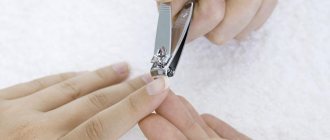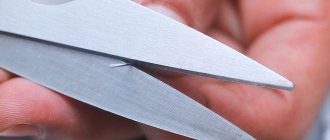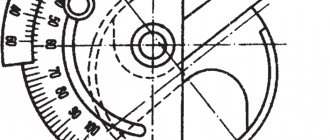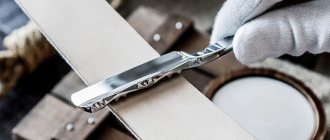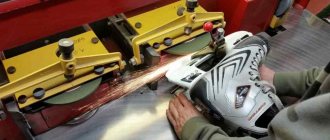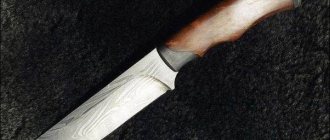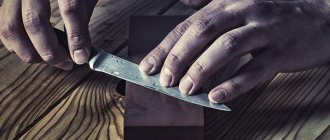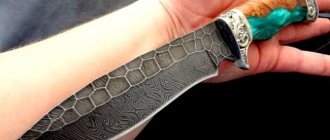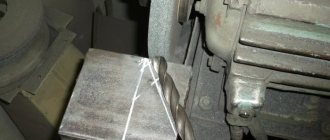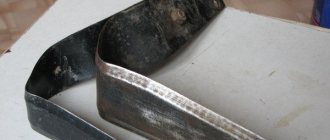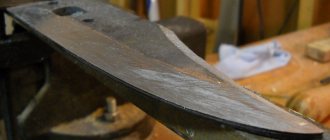Very often the question: “How to sharpen dull scissors at home?” - the answer follows that with a sharpening price of 200-300 rubles, it’s easier to throw them away and buy new ones. However, such advice is most likely only suitable for cheap stamped products made from ordinary structural steel, although it is still better not to throw them away immediately, but to try to sharpen them using available means.
Good household, tailor's and hairdressing scissors are made of durable carbon steel and they are not cheap. Proper sharpening of such a tool is only possible with the use of an abrasive, and you can do it yourself at home.
Several simple and affordable methods using scrap materials allow you to slightly correct the cutting edge. The following describes the best home methods for straightening and sharpening scissors, with which you can restore the cutting properties of this household tool in a short time.
The main mistakes when sharpening scissors
The main conditions for proper operation of household scissors are a tight fit of the knife parts, the correct slope and sharpness of the cutting edge. According to GOST R 51268-99, the sharpening angle of hairdressing scissors should be 60° with a deviation in accuracy from +5 to -15°, and for household, tailoring, etc. scissors - 70° with a possible deviation of ±10°. The surface finish of the internal part and the chamfer of the blade must correspond to the pre-grinding roughness class.
Sharpening scissors at home does not require strict compliance with all these requirements, although this should be strived for. The main mistakes made during home sharpening are:
- linear and angular unevenness of the cutting edge;
- non-compliance with the standard sharpening angle;
- Using too coarse abrasive.
As a rule, the cause of the first two errors is unreliable fixation of the blade in a given position or incorrect operation of the sharpening tool. If the first is quite difficult to achieve at home, then with the second everything is simple: working movements of the blade along the abrasive should be performed only in one direction.
Sharpening methods depending on the type of scissors
There are various types of scissors used in the household, which have different blade shapes and differ in size.
This includes not only household, stationery, hairdressing and tailor's scissors, but also their home varieties such as garden and manicure scissors. Some of them have specific cutting edge angles, many are non-separable, some household scissors are made of hard carbon steel, while others are made of ordinary structural steel. In order to sharpen them correctly at home, you must follow the following rules:
- rigid fixation of the blade being sharpened to ensure uniform geometry along its entire length;
- exact following of the inclination of the sharpening tool to the angle of the cutting edge;
- performing home sharpening from the handle to the end of the blade;
- movement of the sharpening tool in only one direction (most often away from you).
The following are brief descriptions of the sharpening features of the smallest and largest representative of the household scissors family.
VIEW Scissor sharpeners on AliExpress →
Features of sharpening manicure scissors
Homemade manicure scissors have an arched shape, so even a slight inaccuracy in their fastening causes a large divergence at the ends of the blades.
Therefore, before you start sharpening them at home, you first need to eliminate the mounting play. If it is a screw, then the adjustment is made with a screwdriver, and if it is a rivet, then it can be carefully unfastened using a punch or a similar tool, which can always be found in the arsenal of a home craftsman.
To sharpen the cutting edges of this home manicure tool, you will need a thin diamond-coated needle file.
Since their width is only two to three millimeters, some home craftsmen use a magnifying glass with a mount during their work. To fix the scissors, you can use a small homemade vise or a device made from a clamp and wooden blocks.
How to sharpen garden shears
To properly sharpen garden shears in a home workshop, you need a vice, a flat file and a sheet of sanding paper. The scissors can be sharpened in assembled form, but it is better to disassemble them into two halves by unscrewing the nut and removing the tightening screw.
Extraction of the cutting edge should begin from the handle, gradually moving towards the end of the blade. The file must be held strictly along its inclination, and they must be moved only in one direction (usually this is done away from oneself). It is necessary to remove burrs from the treated half, for which its inner plane is ground in a circular motion on a sheet of abrasive paper.
VIEW Sharpener for garden shears on AliExpress →
Types of round disc knives
Rotary knives come in several varieties, each of which has certain advantages. The photo shows that the disk of this knife is capable of cutting fabric in a zigzag pattern. Good zigzag scissors are much more expensive than a rotary knife. It probably makes sense for those who often cut fabric with a tooth to think about buying a round knife with such a blade.
The blades of a rotary knife differ primarily in diameter. The smallest blade diameter is 18mm, then 28mm, the average size is 45mm and the largest is 65mm. Small discs (2) are more convenient to use for cutting small details and curved lines, such as sleeve armholes. The large blade allows you to cut multiple layers of fabric at once.
The cutters themselves are also different. Cutter numbers (1) and (3) are safer because they completely hide the blade. Very comfortable, as they say ergonomic, handles on the cutters numbered (4). But the rotary knife (5) is capable of cutting round parts with a diameter of 4 to 22 cm. Numbered (6) is a rotary knife of the most common model and two spare discs offered in the kit. When buying a knife, immediately purchase a pack of spare blades. The most popular blade size is 45mm in diameter.
The cutter model (7) has a very comfortable handle, and the cutter number (8) has an unusual way of releasing the blade. When you press the handle, a blade appears. If you remove your hand from the handle, the blade is hidden, which is important for those who have small children at home.
How to sharpen homemade scissors
In order to sharpen dull scissors at home, you can use both a traditional abrasive tool and proven folk methods, although some of them seem unusual.
It should be understood that when using grinding bars and wheels for home sharpening, the entire cutting surface is processed, and in other cases, only a slight correction of its pointed edge is performed.
Using a sharpening machine
It is very convenient to sharpen home cutting tools on a special sharpening machine, which is equipped with a device for clamping the product at a given angle and its fixed movement along the grinding wheel.
However, this type of equipment, as a rule, is available only in special workshops or among craftsmen who make knives at home. In principle, in order to sharpen cutting edges to the required sharpness, an ordinary electric sharpener, which is in the arsenal of almost every home workshop, is also suitable. For high-quality home sharpening, a support table is required, since the blades will have to be fixed manually, both in angle and length.
If you have no experience working on such a home machine, then before sharpening the scissors it is better to practice on an unnecessary piece of metal, since it is very easy to ruin them due to inexperience on a home electric sharpener.
VIEW Electric sharpener on AliExpress →
Use of whetstone
In the household, the most popular sharpening tool is the whetstone.
Usually this is a flat rectangular block of fine abrasive, which can be purchased at any tool store. This type of home sharpening requires steady hand and some skill, but if all recommendations are followed, it gives one of the best results. Before starting work, place the block on a piece of cloth and moisten its surface with water. If the household scissors are non-separable, then it must be placed on the edge of the table. If they can be separated, disassemble the scissors into two halves by unscrewing the fastening screw.
Then, holding one of the parts by the ring and handle, fix it at the angle of inclination of the cutting edge and move it with pressure along the surface of the block several dozen times. The movement should be performed away from you and only in one direction.
As you work, regularly inspect the blade and, as soon as it looks smooth and sharp, move on to the other half. After finishing home sharpening on a block, wipe both halves with a napkin and then connect them with a screw.
Using a vice and file
Flat files are used to sharpen the edges of medium and large-sized household scissors.
In this case, a prerequisite is their fixation in a bench vice. For sharpening, ordinary files No. 3–4 or with diamond coating are most often used. Any vice is suitable for this type of work - like those found in any garage or home workshop. When clamping household scissors, they should be carefully aligned vertically, and it is desirable that the end of the blade is completely clamped by the jaws of the vice. They work with a file on their own, moving it strictly in accordance with the angle of the cutting edge. After processing, it is necessary to remove burrs from home scissors using sanding paper.
Sharpening with aluminum foil
This is one of the simplest and most affordable ways to sharpen scissors, because in this case, foil is used, which is used by housewives for baking. To sharpen them in this way, you need to take a piece of foil 20–30 cm long and fold it several times.
Then you need to start cutting thin strips along the entire length, periodically checking the sharpness of the blade on a sheet of paper. This method, like all others, is called home sharpening, although in fact in this case only light editing of the cutting edge occurs, which gives only a temporary result.
We use sandpaper, sponge and steel wool
Probably the most popular home method for quickly sharpening homemade scissors is cutting with sandpaper.
As in the case of aluminum foil, here only the cutting edge is straightened, but with obviously good results. For these purposes, sandpaper with the GOST designation of 10-N and 20-N is best suited. Before starting work, the sandpaper should be folded in half with the abrasive part facing out. You need to cut it into small “noodles” so that the cut covers the entire length of the blades. After a couple of dozen cuts, it is necessary to check for sharpness using a sheet of paper.
In addition to sandpaper, metal wool and Scotch Brite, an abrasive sponge that many housewives use to scrub burnt dishes, are well suited for these purposes.
Metal needle
Dressing the cutting edge with a metal needle also affects only the very edge of the tip of the blade edges. This method uses a thick needle, which is found in every household.
First, you need to grab the can in the middle with the part of the blades closest to the handle. Then, squeezing the rings, make it slide along the cutting edge to the very end, repeating this procedure until the desired result is achieved.
This method is not particularly popular among housewives, because it requires special skill and seems dangerous.
VIEW View scissor sharpeners on AliExpress →
Application of glass jar
Using a glass jar as a tool to restore the sharpness of the edges of homemade scissors causes a skeptical grin from many, but there is evidence that the result in this case is no worse than when cutting with sandpaper.
This home sharpening looks like this: a glass vessel with a diameter of 10–12 cm is held on the table surface with the left hand, and with the right hand, using homemade scissors, an attempt is made to cut it in half.
First, the glass is grabbed by the base of the scissors, wide open to the full width, and then their blades slide along the glass surface to the very end. In this home method, small particles of glass act as an abrasive, which break off when the metal moves over its surface.
How to keep scissors sharp
The first rule for keeping scissors sharp is to always use each type of this household tool only for its intended purpose. This is especially true for hairdressing and tailoring tools.
It is also necessary to remember that household scissors are ordinary metal products made of carbon steel with a thin chrome coating, which are subject to oxidation and rust when sharpened or scratched.
After any contact with water, household scissors must be wiped dry, and they must be stored in a place inaccessible to moisture.
The article lists the most popular home methods for sharpening scissors. But some sources write that cutting foil and sandpaper creates an uneven cutting edge, and after that it is more difficult to sharpen. What do you think about this? Please share your thoughts in the comments to this article.
Quality checking
After sharpening, you need to evaluate the type of tool. It is important to pay attention to how the canvases adhere to each other. It is necessary to check the movement of the devices. It is lightweight, no snagging or jerking. If this is so, then the work will be high quality and accurate.
Since hairdressing scissors are used for cutting hair, you need to check the quality of sharpening using a suitable method. For example, on your own hair or artificial hair. A piece of cotton wool is used for testing. The result will be noticeable on the cut. A well-processed device will last for many years, pleasing you with the results of its work.
